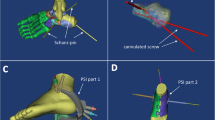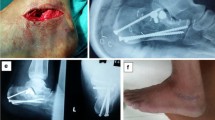Abstract
Aims
Visualization of the subtalar joint surface in surgical management of calcaneal factures remains a big challenge and anatomic reduction of the articular surface is essential for a good clinical outcome. We hypothesize that video-assistance can provide superior fracture reduction compared to fluoroscopy and that nanoscopy (NSC) achieves more extensive visualization compared to fracturoscopy (FSC).
Methods
Ten human cadaveric feet with artificially pre-fractured intraarticular calcaneal fractures with involvement of the posterior facet were treated via a minimal invasive subtalar approach. After initial control of reduction by 2D fluoroscopy, the reduction was further analyzed intraoperatively by FSC and NSC. 3D Scan served as gold standard control of reduction. Need of revision of reduction after the different visualization techniques was recorded and the extent of visualization of the subtalar joint surface in the medio-lateral dimension was compared for FSC and NSC. To quantify access and visualization of the medial and posterior facet, a depth gauge was used to measure from laterally at the clinically widest portion of the calcaneus targeted to the sustentaculum tali. The distance in millimetres was referred to the complete medio-lateral distance seen on paracoronal CT at the widest portion of the calcaneus.
Results
Fracture analysis in preoperative CT-scans according to Sanders classification revealed four type IC, two IIA, three IIC and one IIIAC fractures. Mean visualization of the medial and posterior facet was significantly improved with NSC (30.4 ± 3.78 mm) compared to FSC (23.6 ± 6.17 mm) (p = 0.008). An imperfect reduction requiring revision was more often required with NSC compared to FSC. Insufficient reduction using video-assistance was found in two cases.
Conclusion
In order to optimize subtalar joint reduction and congruency, video-assisted techniques, especially NSC, provide superior visualization and thus can improve reduction in the surgical treatment of intraarticular calcaneal fractures.



Similar content being viewed by others
References
Yu Q, Li Z, Li J, et al. Calcaneal fracture maps and their determinants. J Orthop Surg Res. 2022;17:39. https://doi.org/10.1186/s13018-022-02930-y.
Allegra PR, Rivera S, Desai SS, et al. Intra-articular calcaneus fractures: current concepts review. Foot ankle Orthop. 2020;5:2473011420927334. https://doi.org/10.1177/2473011420927334.
Rammelt S, Bartoníček J, Park K-H. Traumatic injury to the subtalar joint. Foot Ankle Clin. 2018;23:353–74. https://doi.org/10.1016/j.fcl.2018.04.004.
Gavlik JM, Rammelt S, Zwipp H. The use of subtalar arthroscopy in open reduction and internal fixation of intra-articular calcaneal fractures. Injury. 2002;33:63–71. https://doi.org/10.1016/s0020-1383(01)00077-8.
Park CH. Role of subtalar arthroscopy for displaced intra-articular calcaneal fractures. Clin Podiatr Med Surg. 2019;36:233–49. https://doi.org/10.1016/j.cpm.2018.10.006.
Rastegar S, Ravanbod H, Moradi M, et al. Extensile approach versus minimally invasive technique in management of calcaneus fractures. Int J Burns Trauma. 2021;11:27–33.
Halm JA, Beerekamp MSH, de Muinck-Keijzer RJ, et al. Intraoperative effect of 2D vs 3D fluoroscopy on quality of reduction and patient-related outcome in calcaneal fracture surgery. Foot Ankle Int. 2020;41:954–63. https://doi.org/10.1177/1071100720926111.
Gavlik JM, Rammelt S, Zwipp H. Percutaneous, arthroscopically-assisted osteosynthesis of calcaneus fractures. Arch Orthop Trauma Surg. 2002;122:424–8. https://doi.org/10.1007/s00402-002-0397-4.
Queitsch C, Schulz AP, Haustedt N, et al. Improved therapy of calcaneal fractures by intraoperative 3D-fluoroscopy and locked-screw plate fixation. Eur J Trauma. 2006;32:471–6. https://doi.org/10.1007/s00068-006-5045-1.
Stornebrink T, Altink JN, Appelt D, et al. Two-millimetre diameter operative arthroscopy of the ankle is safe and effective. Knee Surg Sport Traumatol Arthrosc. 2020;28:3080–6. https://doi.org/10.1007/s00167-020-05889-7.
Stornebrink T, Emanuel KS, Shimozono Y, et al. A change in scope: redefining minimally invasive. Knee Surg Sport Traumatol Arthrosc. 2020;28:3064–5. https://doi.org/10.1007/s00167-020-05898-6.
Behrendt P, Berninger MT, Thürig G, et al. Anterolateral versus modified posterolateral approach for tibial plateau fractures with involvement of the posterior column: a cadaveric study. Eur J Trauma Emerg Surg. 2022. https://doi.org/10.1007/s00068-022-02113-8.
Weber M, Lehmann O, Sägesser D, et al. Limited open reduction and internal fixation of displaced intra-articular fractures of the calcaneum. J Bone Joint Surg Br. 2008;90-B:1608–16. https://doi.org/10.1302/0301-620X.90B12.20638.
Khazen G, Rassi CK. Sinus tarsi approach for calcaneal fractures. Foot Ankle Clin. 2020;25:667–81. https://doi.org/10.1016/j.fcl.2020.08.003.
Park CH, Yoon DH. Role of subtalar arthroscopy in operative treatment of sanders type 2 calcaneal fractures using a sinus tarsi approach. Foot Ankle Int. 2018;39:443–9. https://doi.org/10.1177/1071100717746181.
Sangeorzan BJ, Ananthakrishnan D, Tencer AF. Contact characteristics of the subtalar joint after a simulated calcaneus fracture. J Orthop Trauma. 1995;9:251–8.
Bremer AK, Kraler L, Frauchiger L, et al. Limited open reduction and internal fixation of calcaneal fractures. Foot Ankle Int. 2020;41:57–62. https://doi.org/10.1177/1071100719873273.
Nosewicz TL, Dingemans SA, Backes M, et al. A systematic review and meta-analysis of the sinus tarsi and extended lateral approach in the operative treatment of displaced intra-articular calcaneal fractures. Foot Ankle Surg. 2019;25:580–8. https://doi.org/10.1016/j.fas.2018.08.006.
Behrendt P, Berninger MT, Thürig G, et al. Nanoscopy and an extended lateral approach can improve the management of latero-central segments in tibial plateau fractures: a cadaveric study. Eur J Trauma Emerg Surg. 2022. https://doi.org/10.1007/s00068-022-02188-3.
von Recum J, Wendl K, Vock B, et al. [Intraoperative 3D C-arm imaging. State of the art]. Unfallchirurg. 2012;115:196–201. https://doi.org/10.1007/s00113-011-2119-2.
Geerling J, Kendoff D, Citak M, et al. Intraoperative 3D imaging in calcaneal fracture care-clinical implications and decision making. J Trauma. 2009;66:768–73. https://doi.org/10.1097/TA.0b013e31816275c7.
Acknowledgements
None.
Funding
This research project was funded by Arthrex Inc. Arthrex GmbH, Siemens Healthineers, Deutsche Kniegesellschaft.
Author information
Authors and Affiliations
Contributions
Conceptualization JD, MB, PB, KHF, MJH; methodology JD, MB, PB, KHF, MJH; validation JD, MB, PB, KHF, MJH; formal analysis JD, MB; investigation JD, MB, PB, KHF, MJH, JK, GT, FRP; writing—original draft preparation JD, MB; writing—review and editing. All authors; visualization JD, MB, PB, NH; supervision KHF, MJH.; project administration JD, MB, PB, KHF, MJH; funding acquisition PB, KHF, MJH. All authors have read and agreed to the final version of this manuscript.
Corresponding author
Ethics declarations
Conflict of interest
The authors declare that this study was supported by Arthrex Inc. and Siemens. The funders had no role in the design of the study, in the collection, analyses, or interpretation of data, in the writing of the manuscript, or in the decision to publish the results. PB and GT received a fellowship by the German Knee Society (DKG) financed by Arthrex during the study.
Ethical approval
The study was conducted according to the guidelines of the Declaration of Helsinki and approved by the institutional Ethics Committee of the University of Hamburg.
Rights and permissions
Springer Nature or its licensor (e.g. a society or other partner) holds exclusive rights to this article under a publishing agreement with the author(s) or other rightsholder(s); author self-archiving of the accepted manuscript version of this article is solely governed by the terms of such publishing agreement and applicable law.
About this article
Cite this article
Dehoust, J., Berninger, M.T., Behrendt, P. et al. Comparison of different intraoperative reduction monitoring methods in a cadaveric intraarticular calcaneal fracture model: 3D scan vs arthroscopy vs nanoscopy. Eur J Trauma Emerg Surg 49, 2561–2567 (2023). https://doi.org/10.1007/s00068-023-02330-9
Received:
Accepted:
Published:
Issue Date:
DOI: https://doi.org/10.1007/s00068-023-02330-9




